You’ll Never Listen
Not long ago, I wrote a lesson giving each handicap level three tips for improving their approach game [read it HERE]. The main takeaway was, “Stop coming up short. Hit more club.”
In the days after I wrote that, I spent some time thinking about why this advice is universal and timeless. The answer I reached comes in four parts, and I’ll share them in this lesson.
This Lesson Is For You If:
You want to hit more greens and shoot lower scores
Mental & Emotional Pain
Can you think of a time when you listened to that sage advice of taking more club only to strike it pure and airmail the green? I bet you can. Even if you can’t recall the exact date and time, you know the feeling.
Can you think of a time when you pulled the club that you wanted to hit – the “If I flush this, it’ll be perfect” club – hit it slightly on the toe, and came up ten yards short? Unless there were some serious stakes on that shot, I’d bet that you can’t.
Why is there this discrepancy? Because one shot caused you more mental and emotional pain. In that first example, you did what someone else told you to do rather than trusting yourself, and you were “punished” for it. That sears the memory into your brain. Now every time you step up to a long par 3, that emotional memory pops up telling you to ignore the “haters” and hit the club that your gut says is right.
If you want to shoot better scores, focus on the process. Feel good that you made a smart, high probability decision, regardless of the outcome. You can also focus on the long term improvement of your GIR stats rather than the occasional shot that flies the green.
Fairness
The concept of fairness is inextricably tied to the emotional pain I just mentioned. We have this notion that, if we mishit our shot, we “deserve” a bad result. We can live with that. However, if we take that extra club, hit it pure, and end up over the green, that’s “unfair.”
It doesn’t take a modern day Socrates to punch holes in the idea that golf is fair. We putt on living surfaces that get walked on all day long, resulting in uneven rolls and bad breaks. A gust of wind can turn a potential hole in one into a water ball. Golf is unfair. As soon as you accept this, you’ll have an advantage on your competitors.
High Hopes
No successful golfer has ever walked into a shot thinking about hitting it a little chunky or slapping the ball off the toe. We expect to hit every next shot perfectly. And this makes sense – the whole field of sports and performance psychology tells us to think positively! So, with the assumption that we’re going to deliver a perfect strike, why would we not choose the club that will reach the pin only with an ideal swing?
The marriage of golf strategy and golf psychology is a difficult thing. To shoot our best scores, we need to pick conservative targets and clubs, then swing aggressively with positive thoughts. This is a very difficult balance to maintain.
Ego
You knew this one was coming. If your playing partner is hitting an 8I, you’re hitting a damn 8I, too. It doesn’t matter that they’re 10 years younger, 20 pounds lighter, practice three times more, or that their 8I has the same loft as your 6I. You will not suffer the indignity of hitting more club!
There’s no clever tip to solve this one. You can choose to get over yourself or not.
Know What You’re Doing
If you thought I was going to end this lesson by chiding you about making bad club selections, you’re wrong. All I’m going to ask is that you be aware of what you’re doing.
Your game is your own. If you want to adhere to your personal notions of fairness, maintain your ego, and avoid mental pain, you should do that. Just know that you’re costing yourself strokes, and don’t complain that your handicap never goes down. Alternately, if you want to shoot the lowest possible scores, know that you’ll have to live with some shots that go too far. There are no bad choices as long as you know what you’re doing.
He founded Plugged In Golf in 2013 with the goal of helping all golfers play better and enjoy the game more.
Matt lives in the northwest suburbs of Chicago with his wife and two daughters.
- Performance Golf Click Stick Training Aid Review - October 18, 2024
- Callaway Opus Platinum Wedge Review - October 17, 2024
- When to Take a Break from Golf - October 15, 2024





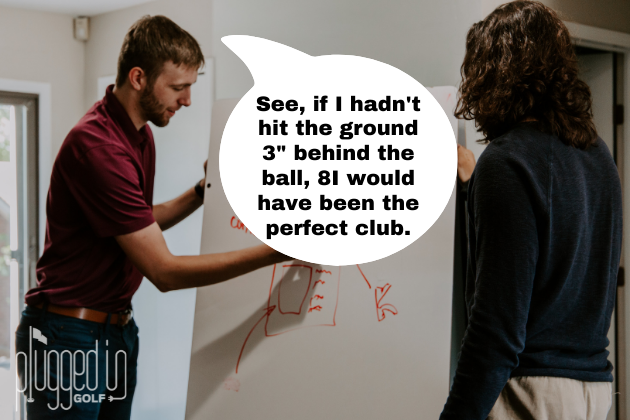
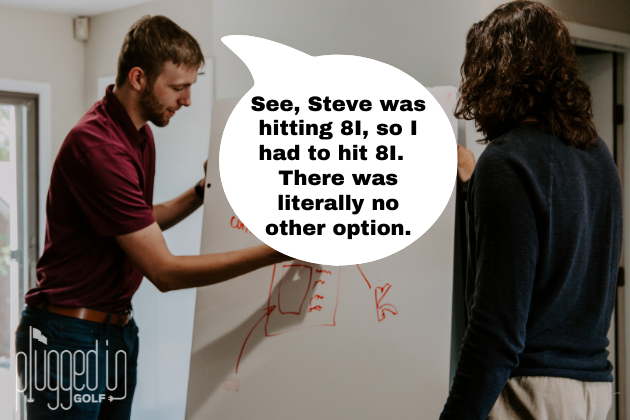

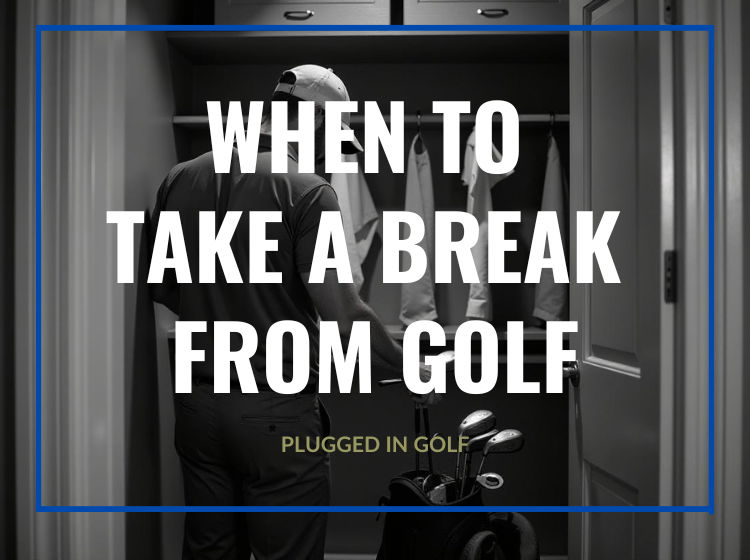
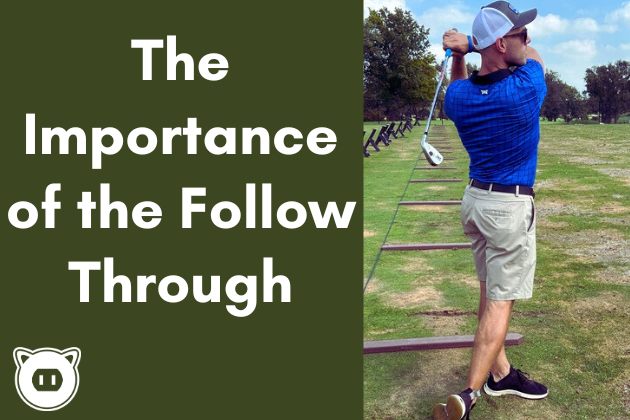
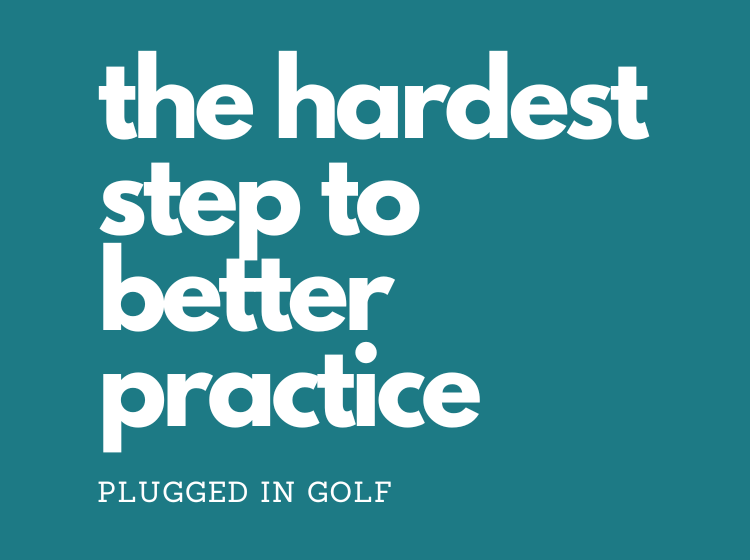









18 Comments
This is very interesting. I spend a lot of time on course management and tend to hit the longer club when pin is up front, and shorter club when pin is back. I do think two issues that exacerbates the problem are: 1) there is usually more trouble long; and 2) most people have no idea how far they actually hit each club. Even when I say to someone I am hitting a 7 iron from 155 they tell me it is too much club! I know if I flush it, it goes 160 but they think it goes 170! People’s perception is a huge issue.
I wish I understood what you’re trying to say.
Also, why do you tell people what iron you are hitting?
He’s saying that a couple issues tend to lead to people not taking enough club. One, on many holes trouble is long so they play conservatively and come up short. Seems like an ok result if trouble is truly long. Two, people remember the one time they carried a 7 iron 170 yards and use that as their marker forever more. In reality, their true carry distance is closer to 160 yards.
I imagine like lots of us he’s responding to his buddies asking “what club are you hitting” as he heads to tee up. It’s almost useless information when you tell them you’re hitting a 7 iron (it’s 34 degrees) and know they’re carrying 28 degree 7 irons in their bags.
Thanks Matt, you’re so right to re-emphasize this continued lesson. This is one I’ve learned to etch deeply into the psyche. Take more club, swing smoothly. Be conscious and committed to your shot choices.
Like life, not everything is fair, but be patient and trust there will be a good outcome, and you’ll be pleasantly surprised that things can turn around. As we often hear from the professional tour players, they learn more from their bad rounds than their good ones. That’s true if you have a good inner instructor. If you don’t, then it’s just more reason to beat up on yourself. I heard a guy this week, as part of his pre-shot routine for his chip, say out loud and emphatically to himself, “okay, now just don’t f@#$ this up, you idiot!”. Whoa. Brutal. Isn’t this game tough enough? They way I measure the destructive versus supportive factor of a persons self-talk, is by thinking about somebody saying it to their child.
To your point, I don’t look at my playing partners club to make a choice. It takes me out of my own assessment and creates doubt when I’ve already intuitively determined the right club for my perceived shot, which pretty much happens as soon as I reach the tee box or see my ball. I rarely hit the same distances that they do, and I enjoy hitting different shots with different lofts when they may be praying to not make a bad shot with their one and only shot shape. I’ll frequently play with 8 or 9 clubs rather than 14, which I have really come to enjoy (a carry over from playing more rounds with 100 year old hickory shaft clubs), so asking what they hit makes it an even more arbitrary measure.
Note: I noticed your 8 club setup and smiled. Fabulous isn’t it?
One thing you didn’t mention, in addition to being fearful of hitting over the green, is a lot of players are afraid of hitting downhill putts to front pins. Broadcasters often say it on TV, “Oh, his ball stopped above the hole, now he has a really tough downhill putt.” The fear of putting downhill is mortifying to some, and the notion of putting off the green only amplifies it. It’s more humiliating than hitting over the green. Yet, when they do come up short of the green, with the ball in chipping range, I see how many go into fear factor mode because their short game is unreliable (at best). Pick your poison I guess.
As you said Matt, I didn’t realize how often I was coming up short on the greens, but once I started documenting my rounds and noted the number of times I did, I had to consciously correct it. Old habits, right? I deliberately had to trust it and was able to assimilate it with excellent returns. It takes a lot of practice to overcome that old tendency and trust it enough to put into competitive rounds.
A few years ago, I stopped using my range finder and began using a gps watch and my scores dropped significantly since then — from upper single digit to low single/+. The range finder was fabulous when it came out, a huge upgrade from when we were walking it off from sprinkler heads or 150 markers. The pinpoint laser made the flag the target, because my mind was singularly focused on it. It was part of my evolution, but I have a new strategy.
I switched to a gps watch and my target became center of the green. Even when everything is telling me (screaming at me) go for the pin, I stick to the center of the green — no matter how tempting it may be. It takes discipline to sustain that intention, making sure that the powerful subliminal directive (ego mind), that so desperately tells me to go for it, doesn’t override my conscious choice. Aggressive shots to conservative targets — now going over the back, or pulling up short, happens less frequently. By tuning into the center of the green, I attain a much wider field of vision, a full intuitive sense of the shot, taking in the entire situation, rather than getting myopic and missing the other factors when that image of the pin is burned into my mind with the range finder.
It’s not a rigid formula, if the pin is way back, and I have the center of the green number and back of the green distance, I may add a couple yards to the center number, and conversely, for pins up front, I’ll subtract a couple from center — a couple yards longer or shorter is within my margin of error. In windy conditions, I reverse or add to those additions/subtractions. When I’m in close with a scoring wedge in my hand, inside 130 yards, I may pull out my range finder to get the absolute number, and go right at it — as always, given the right conditions.
As you said, know what you’re doing. Once I’ve committed to my shot I am solidly behind my choice — no doubts, no distractions — willing to accept the outcome, because it was my choice, not a fear-based default. No blame. No shame. Solid intention and commitment. Confidence is everything in this game — and in life for that matter.
My playing partners say I have a boring game. I play quickly and generally take more club, and swing smoothly for my number, whereas they take less club, grind over their shots and swing out of their shoes. As you said, maybe once out of 5 times they’ll hit it on the screws and it’s heroic, but in the end they’re struggling to break 80, and I’m disappointed when I don’t break par each round. I have found reliable consistency, which yields low scores — it’s not heroic, but when the scores are added up, they will count and recount, to find I have quietly snuck in with a score in the 60s…again. Borrring!
As always Matt, thank you. Your excellent equipment reviews and sound instruction are deeply appreciated. I use your reviews to guide me through the vast amount of advertising hype and hyperbole to identify the right equipment direction, and when I study and assimilate your instructional advice, I become a better player because of it.
Thank You Jay for a great thoughtful email. Have a Happy Thanksgiving. Bill Bogey
Well done Matt! This may be your single best article yet! Happy Thanksgiving!
Can understand the advice, but generally trouble is behind green and short is fine.
It’s infuriating to flush it and hit into tress or oob’s, I’d rather chance a mishit and chip on.
Good sound advice. Thx Matt.👍
underclubbing is one of golf’s cardinal sins. I suggest you and your readers take a look at Will Robins’ “The Scoring Method” . Has revolutionized the way I play and practice.
Well I have one thing to say on club selection. I play with fellows who hit it long and their ego is just as big. They tell me what they hit and I tell them what in hitting, I always answer with is. Let me check back with you in a few years and see what you’re hitting. I’m 76, playing in guys who are in the 50’s early 60’s. Big difference! Let’s check the score at the end.
Thanks Matt – I have also started to manually record my ‘short’ shots and surprisingly – I am now in the mode of going for the middle of the green and leave it to my putting skills to finish off the hole.
Now, not always works out but, I now know my mis hits and taking steps to correct them.
Cheers
This makes sense on a logical level, but is it correct? I assume this article is aimed at mid to high handicap players. The approach to automatically “take more club” assumes that the player is going to equally mishit their longer iron compared to the shorter iron option. However, it seems reasonable that a mid to high handicap player will, on average, mishit to a greater extent a longer, lower lofted club. This seems like a great theory to test in a Mythbusters segment.
Super article!
I wish my misses were almost always short. I love the article, but for me “take more club” is on par with “swing easy”. Both lead tend to lead to bad outcomes. Take the right club and swing crisply resonate better with me. Short at my club can still be par or bogey while long can mean worse. Plus my data says missing short is not my issue even though I am a high handicapper at 14.
Maybe I’m in the minority, but for me coming up short is almost always better than going long unless I have to carry a water hazard. Going long on the courses I play means going into super thick rough, a hazard, or out of bounds. Coming up short on most holes means a chip and putt for par, bogey at worst. This advice might be the go for those who are perpetually hitting two clubs less then they should because of their ego, but If I catch my 3-iron perfect it goes 235 yards rather than the 220 I expected it to. If I hit it fat and it goes 190, so be it.
Brad,
I would agree that trouble long is sometimes a concern, but the data shows that players all the way to scratch leave their shots short many times more often than they go long. This indicates bad target choice and/or bad club selection.
-Matt
I agree, but I think it is definitely dependant on the courses you play. The course I play most often here in Queensland is dead if you are long of the hole for all but three of the holes. Most of those holes either slope steeply down a hill at the back toward a hazard or have a hazard within three paces of the back of the green. 13 of the 18 holes also have the green sloping fairly strongly back to front, which means a chip or putt from off or on the back side of the green will be moving with a lot of pace towards the hole and will be hard to stop. If you want to play smart on my course, you don’t want to go past the middle of the green unless the pin is at the back and you are birdie hunting. If you end up short of the green (with the exception of three holes where you will find water short), you can just pitch or chip it with a bit of pace to get to the hole up the slope, but going long makes for a very long day most of the time.
Way cool! Some very valid points! I appreciate you writing this write-up plus the rest of
the site is very good.